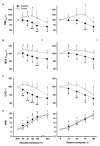Cerebral vs. Cardiovascular Responses to Exercise in Type 2 Diabetic Patients
- PMID: 33519500
- PMCID: PMC7844205
- DOI: 10.3389/fphys.2020.583155
Cerebral vs. Cardiovascular Responses to Exercise in Type 2 Diabetic Patients
Abstract
The human brain is constantly active and even small limitations to cerebral blood flow (CBF) may be critical for preserving oxygen and substrate supply, e.g., during exercise and hypoxia. Exhaustive exercise evokes a competition for the supply of oxygenated blood between the brain and the working muscles, and inability to increase cardiac output sufficiently during exercise may jeopardize cerebral perfusion of relevance for diabetic patients. The challenge in diabetes care is to optimize metabolic control to slow progression of vascular disease, but likely because of a limited ability to increase cardiac output, these patients perceive aerobic exercise to be more strenuous than healthy subjects and that limits the possibility to apply physical activity as a preventive lifestyle intervention. In this review, we consider the effects of functional activation by exercise on the brain and how it contributes to understanding the control of CBF with the limited exercise tolerance experienced by type 2 diabetic patients. Whether a decline in cerebral oxygenation and thereby reduced neural drive to working muscles plays a role for "central" fatigue during exhaustive exercise is addressed in relation to brain's attenuated vascular response to exercise in type 2 diabetic subjects.
Keywords: cardiac output; cerebral blood flow; cerebral metabolism; cerebral oxygenation; diabetes; vascular conductance.
Copyright © 2021 Kim, van der Ster, Brassard, Secher and van Lieshout.
Conflict of interest statement
The authors declare that the research was conducted in the absence of any commercial or financial relationships that could be construed as a potential conflict of interest.
Figures


Similar articles
-
Impaired cerebral blood flow and oxygenation during exercise in type 2 diabetic patients.Physiol Rep. 2015 Jun;3(6):e12430. doi: 10.14814/phy2.12430. Physiol Rep. 2015. PMID: 26109188 Free PMC article.
-
Sympathetic influence on cerebral blood flow and metabolism during exercise in humans.Prog Neurobiol. 2011 Nov;95(3):406-26. doi: 10.1016/j.pneurobio.2011.09.008. Epub 2011 Sep 24. Prog Neurobiol. 2011. PMID: 21963551 Review.
-
Cerebral blood flow and metabolism during exercise: implications for fatigue.J Appl Physiol (1985). 2008 Jan;104(1):306-14. doi: 10.1152/japplphysiol.00853.2007. Epub 2007 Oct 25. J Appl Physiol (1985). 2008. PMID: 17962575 Review.
-
Exertional Desaturation in Idiopathic Pulmonary Fibrosis: The Role of Oxygen Supplementation in Modifying Cerebral-Skeletal Muscle Oxygenation and Systemic Hemodynamics.Respiration. 2021;100(6):463-475. doi: 10.1159/000514320. Epub 2021 Mar 30. Respiration. 2021. PMID: 33784706 Clinical Trial.
-
Regulation of cerebral blood flow and metabolism during exercise.Exp Physiol. 2017 Nov 1;102(11):1356-1371. doi: 10.1113/EP086249. Epub 2017 Sep 30. Exp Physiol. 2017. PMID: 28786150 Review.
Cited by
-
Neurovascular Dysregulation During Exercise in Type 2 Diabetes.Front Physiol. 2021 Apr 13;12:628840. doi: 10.3389/fphys.2021.628840. eCollection 2021. Front Physiol. 2021. PMID: 33927637 Free PMC article. Review.
-
Effects of noradrenaline and phenylephrine on cerebral oxygen saturation during cardiopulmonary bypass in cardiac surgery.Exp Physiol. 2025 Jun;110(6):798-808. doi: 10.1113/EP092387. Epub 2025 Jan 23. Exp Physiol. 2025. PMID: 39853666 Free PMC article. Clinical Trial.
References
Publication types
LinkOut - more resources
Full Text Sources
Other Literature Sources

